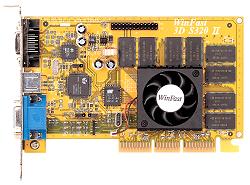The Specifications
| There are those that will argue that the TNT2 is much more than the original TNT running at a higher clock speed, and in some respects, this is true. The TNT2’s rendering pipeline has apparently been tweaked a little by nVidia, and the TNT2 chip itself is now built upon a 0.25 micron die, a welcome change from the blazingly hot 0.35 micron wafers that the original TNTs were cut from. |  |
On the other hand, the TNT2 brings nothing dramatically new to the table, the feature set remains virtually unchanged, and the essence of the TNT remains strong in the TNT2. But have a look for yourself, as the official specs on the final revision of nVidia’s Riva TNT2 are listed below:
- 125MHz – 150+MHz 128-bit 2D/3D core
- 2nd Generation 128-bit TwiN Texel architecture
- 300 Megapixels per second
- 9 Million Triangles per second peak processing power
- Resolution support up to 2046 x 1536
- PCI/AGP Support – AGP 2X/4X Texturing Support
- 16/32-bit 3D Rendering Support
- 32-bit Z/stencil Buffer
- 300MHz Integrated RAMDAC
- 16/32MB SDRAM
- 2048 x 2048 Texture Support
- Optional NTSC/PAL Video Out
- Optional Digital Flat Panel Output
- Direct3D/OpenGL API Support
- OpenGL ICD for Windows 9x, NT 3.5x, NT 4.0, and Windows 2000
Defining the TNT2
If a company does not improve on their weaknesses, their chances for success in the future are limited, right? So it makes perfect sense that nVidia should want to concentrate on their weaknesses with the TNT2, since it would make no sense to release a new product that did not offer a significant improvement over the previous flagship of the company. The first problem nVidia addressed with the TNT2 was that of clock speed, which directly effects heat production, another problem with the original TNT.
The TNT was initially supposed to ship, by the time nVidia started hinting at numbers to the media, at a core clock speed of 125MHz. If you’ve ever owned or read a review of a TNT based card, you’ll know that the 125MHz core clock never made it down to the end user, instead it was replaced by a more "comfortable" 90MHz setting. The drop from 125MHz down to 90MHz is what cost nVidia the performance race against 3dfx, and at the same time it brought nVidia more bad publicity than they could possibly have asked for. The company eventually made an announcement stating that in 6 months, a 125MHz TNT product would eventually hit the streets on a 0.25-micron silicon wafer. Now, in 1999, nVidia is finally ready to deliver on that promise.
The TNT2 starts off with an initial clock speed of 125MHz, however the technique nVidia is pushing with the release of the TNT2 is much like indirect support for overclocking. There is no clear division among the different clock speeds of TNT2 solutions as there are in the realm of the Voodoo3, rather nVidia is encouraging board manufacturers to explore whatever possibilities exist, with clock speed "suggestions" roaming around the 125MHz and 150MHz marks.










0 Comments
View All Comments